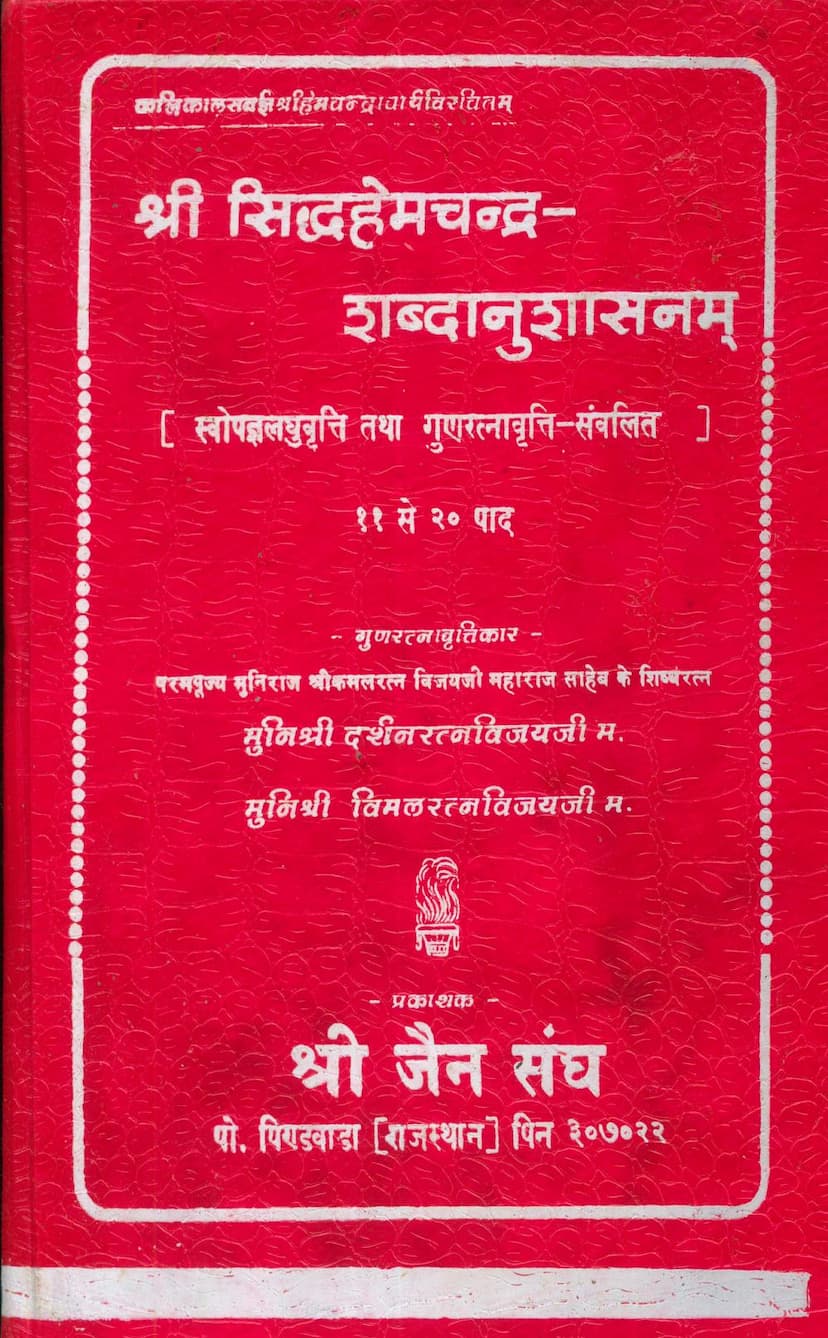Siddh Hemchandra Vyakaranam Part 02
Added to library: September 2, 2025

Summary
This is a comprehensive summary of the Jain text "Siddh Hemchandra Vyakaranam Part 02," authored by Darshanratnavijay and Vimalratnavijay, and published by Shri Jain Shravika Sangh. This summary is based on the provided text, which primarily focuses on grammar (vyakarana) rules within the Jain tradition, specifically covering parts 11 to 20 of the larger work.
Book Title: Siddh Hemchandra Vyakaranam Part 02 Author(s): Darshanratnavijay, Vimalratnavijay Publisher: Jain Shravika Sangh Catalog Link: https://jainqq.org/explore/002228/1
Overall Summary:
The provided text is the second part of the "Siddh Hemchandra Vyakaranam," a significant work on Jain grammar attributed to Acharya Hemchandrasuri. This volume, specifically covering sections 11 to 20 (known as padas), delves deeply into various aspects of Sanskrit grammar as interpreted and applied within the Jain tradition. The commentary includes the Swopajnya Laghuvrutti and the Gunaratnavrutti, indicating a layered and detailed explanation of the original sutras. The text is presented with the intention of being useful for Sadhus and Sadhvis during their travels (vihar).
Key Themes and Content:
The book is structured into chapters (implied by the padas and grammatical categories discussed) and is a rigorous grammatical treatise. Based on the content from pages 8 onwards, which represent the actual grammatical analysis, the following key areas are covered:
- Morphology and Verb Conjugation: A significant portion of the text focuses on verb roots (dhatus), their conjugation in various tenses (like vartaman - present, paroksha - past, ashir - optative, shvastani - future), moods, and voices (parasamaipadam - active, atmanepadam - middle voice). The text meticulously explains the application of specific grammatical rules (sutras) to different verb forms, providing numerous examples.
- Formation of Nouns and Suffixes: The text details the rules for forming nouns from verbs and other roots. It discusses various suffixes (pratyayas) like kyap, kyang, kyu, kt, ktvat, nin, un, shal, etc., and their grammatical implications in terms of meaning, case, gender, and number.
- Application of Rules with Examples: Each grammatical rule is illustrated with specific examples from Sanskrit, showing how the rule is applied to derive the correct form of a word. The commentary clarifies exceptions, special cases, and the rationale behind certain grammatical formations.
- Specific Grammatical Concepts: The text covers a wide range of grammatical concepts, including:
- Vriddhi and Guna: Rules related to vowel changes (vriddhi and guna).
- Samjnas (Technical Terms): Definitions and usage of various grammatical terms.
- Sandhi: Rules for the joining of words or sounds.
- Derivation of Roots: The text discusses how roots are modified by prefixes (upasargas) and how suffixes change their meaning and form.
- Atmanepada and Parasamaipadam: The distinction and application of these verb endings.
- Dhatupatha: The study of verb roots, often referencing their meanings and grammatical properties.
- Special Rules for Specific Verbs and Prefixes: Many sutras are dedicated to particular verb roots or combinations with prefixes that have unique grammatical behaviors.
- Commentaries: The presence of Swopajnya Laghuvrutti and Gunaratnavrutti signifies that the text is not merely a collection of sutras but includes valuable explanations and interpretations, likely by Acharya Hemchandrasuri himself and later scholars.
- Dedication and Publication: The initial pages mention the veneration of certain Acharyas (like Vijay Masursurishwarji, Vijay Ramchandra Surishwarji, and Vijay Jumburiji) and the support from the Jain community (Pindwada Sangh, sisters from Pindwada Jain Sangh, Seth Kalyanji Sobhagchandji Jain Pedhi Trust, etc.) in publishing this work. The publication date is noted as Vikram Samvat 2043 (1986 CE).
Structure and Scope (Implied):
While the summary only provides snippets of the grammatical analysis, it's clear that the book follows a systematic approach to grammar. The detailed explanations of specific sutras, root modifications, and the application of various suffixes suggest a comprehensive coverage of verb and noun morphology. The mention of it being useful for the vihar of Sadhus and Sadhvis indicates its practical application in their study and religious discourse.
In essence, "Siddh Hemchandra Vyakaranam Part 02" is a scholarly and detailed grammatical text essential for understanding Sanskrit within the philosophical and linguistic framework of Jainism. It meticulously explains the rules of word formation and verb conjugation, providing a deep insight into the grammatical tradition championed by Acharya Hemchandrasuri.